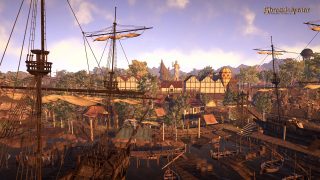A legend returns ?
One thing for sure is that as soon as the game begins – with a rather cheesy and meta opening sequence telling us how we, the player, ended up transported toward New Britannia, everything is crafted to give any old timers a rather pleasing sense of familiarity. With its character creation made as part of the game as the player choose his physical “manisfestation” before being questioned by the mysterious Oracle on the three Principles of Love, Truth and Courage whose answers will guide the first hours of the game after passing through a “Lunar Rift”, hard not to get the feeling that you’re back into a good old Ultima game.
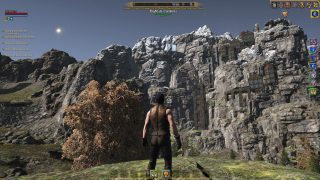 No doubts about it Richard Garriott stays true to his ideas and you can immediately feel his desire to go back to his roots. Plunged on New Britannia, 400 years after one of the moons lead to the devastations of the world as its “Shards” fell upon Britannia… we discover a civilization rebuilt on the land of Novia, guided by the three Principles and the Eight Virtues of Ultima… But something is amiss as the people seem to have gradually forgotten the true sense of the Virtues just as the three mysterious Titans that erected them have disappeared while various threats endanger the great regions of Novia. And that’s not even mentioning this mysterious force, heir to the ancient Obsidians, who seems hellbent on wiping all traces of Virtues from the entire world…
No doubts about it Richard Garriott stays true to his ideas and you can immediately feel his desire to go back to his roots. Plunged on New Britannia, 400 years after one of the moons lead to the devastations of the world as its “Shards” fell upon Britannia… we discover a civilization rebuilt on the land of Novia, guided by the three Principles and the Eight Virtues of Ultima… But something is amiss as the people seem to have gradually forgotten the true sense of the Virtues just as the three mysterious Titans that erected them have disappeared while various threats endanger the great regions of Novia. And that’s not even mentioning this mysterious force, heir to the ancient Obsidians, who seems hellbent on wiping all traces of Virtues from the entire world…
Thus Virtues are at the core of Shroud of the Avatar’s plot, leading the player to follow their path while seeking the pierce the mystery of the mysterious Dirae Prophecy. While the Eight Virtues are more or less represented, it’s more precisely the path of the three Principles that the player will follow, as the adventure is split into three Path, each guiding us in a different region of Novia : the path of Truth, the path of Love, the path of Courage, before finally all joining up together in a final act.
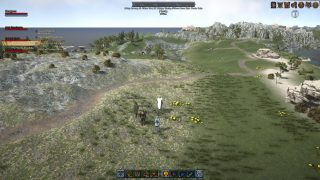 This return to the roots can also be felt by some design decisions, most notably the choice to return to an overland map like the first five Ultima games rather than to the seamless world of the later games. Thus the player can just move around as he or she wants on Novia’s overland, get to the numerous cities on the surface or the various SCENES all over the worlds : zones of exploration or dungeons that can sometime have quests or NPCs and might even join with one another without having to go back to the overland. Same with dialogues which returns to a traditional keyword system with the usual “Name,” “Job,” “Bye,” and that you can also type with the keyboard!
This return to the roots can also be felt by some design decisions, most notably the choice to return to an overland map like the first five Ultima games rather than to the seamless world of the later games. Thus the player can just move around as he or she wants on Novia’s overland, get to the numerous cities on the surface or the various SCENES all over the worlds : zones of exploration or dungeons that can sometime have quests or NPCs and might even join with one another without having to go back to the overland. Same with dialogues which returns to a traditional keyword system with the usual “Name,” “Job,” “Bye,” and that you can also type with the keyboard!
A tainted Legend…
But in spite of what seems on paper as a nice premise, the first thing hitting you as you begin the game is more the title’s presentation which can quickly temper one’s enthusiasm. Now we can be forgiving about the graphics: we’re not in front of a AAA game and if the dated feel of the graphics is rather obvious, it’s mostly made up for by an excellent art direction which immediately reminds us of Ultima and particularly of its final episode which shared the same art director : Scott Jones. It’s also nice that the game doesn’t just mimic the sort of stuff we’re used to see in Britannia and offer a lot more variety like the Viking-inspired lands of Norgard or the regions of Ardoris mixing rather effectively medieval and asian influence. The same goes about the environments and scenery which will go from snowed plains to desert wastelands, and some of the places offers a really pleasant tone and atmosphere, like for instance the Kobold city that seems to come right out of Ultima Underworld or the impressive “Shardfalls” housing the shards of the Moon that fell on Novia and are host to a really crazy (and dangerous) flora! Not to the mention the fact that these SCENES tend to have an excellent world design with a vertically that wouldn’t feel out of place in a Piranha Bytes game.
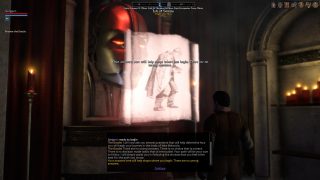 The game mechanics has its qualities as well. It’s mostly based on a skill system that you improve by using them like in Ultima Online, but to which is added an experience points that you gain whenever you do something like solving a quest or killing a monster. Each of those actions will add experience to a global pool where using a skill will come take XP from that pool. The number of skills is staggering with many different skill categories split into two types (adventure skills and crafting skills) where every category has its own skill tree. Between all the various type of weapon and magic, combat styles, and crafting possibilities… let’s just say the possibilities are endless!
The game mechanics has its qualities as well. It’s mostly based on a skill system that you improve by using them like in Ultima Online, but to which is added an experience points that you gain whenever you do something like solving a quest or killing a monster. Each of those actions will add experience to a global pool where using a skill will come take XP from that pool. The number of skills is staggering with many different skill categories split into two types (adventure skills and crafting skills) where every category has its own skill tree. Between all the various type of weapon and magic, combat styles, and crafting possibilities… let’s just say the possibilities are endless!
In term of combat it works pretty well as well. At first glance it looks like just your regular system with attacks skills (represented as Glyphs) and cooldowns like so many RPGs and MMOs… however by looking at it more in depth, one realize it is more complex that it might look at first glance and that by fighting solely by randomly clicking on each glyph, you’ll soon hit a wall. There are basically two ways to lead a fight, the first is to simply put your skills on your shortcut bar… and to “charge” attacks by holding the associated key. The longer you hold, the more powerful and effective the attack will be depending on the charge level, taking into account that the more you charge the attack, the longer it will take to recharge. You then switch between different attacks as needed. The other method consist of creating a “deck” of Glyphs that will be pulled randomly much like a card game, with the possibility of creating combos to launch “super attacks” depending on the order of the Glyphs. So both systems have their pro and cons and one will use or of the other based on their own preferences, but each is pretty interesting by itself.
It’s a shame however that the game itself does a pretty poor job of explaining all these games systems even though the core mechanics end up on a mostly positive note once you get the hang of it.
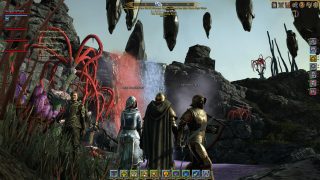 But, but, but… in spite of all these undeniable qualities, it’s hard to get the sense that something is inherently wrong here. As far as graphics goes, there is this underlying feeling that the end result just doesn’t look as good as it could, as if it were missing some effects, shaders, or post-processing to polish it all. Thus adding to this sentiment of seeing something that is “not finished”. But that’s really not the worst of it, because the thing that really spoils it all is the horrendous user interface. As far as I can remember, I’d have a hard time naming a game whose UI looks so horribly cheap with visual sthat looks so amateurish it can only leaves you perplexed. Whether it’s the look of the menus, of the compass, of the inventory or even simply the font used for the game, everything about the UI is so bad that it’s quite simple really : it makes the game look worse than it really is. The worst offender here really is the dialogue UI which basically looks like an IRC chat window put in the middle of the screen with a few keywords added to click on. Not immersive –at all–. And this is supposed to be a professional release? In truth really, the whole User Interface feels like a placeholder UI that was quickly put together in the early months of game development… and eventually everybody got so used to it that they just forgot the replace with the proper one before release. Unthinkable! And the craziest thing about it is that during the earlier prototypes and pre-alpha of Shroud of the Avatar, the game had a much more visually UI both for its inventory, its interactivity and its dialogues. So what the hell happened here?
But, but, but… in spite of all these undeniable qualities, it’s hard to get the sense that something is inherently wrong here. As far as graphics goes, there is this underlying feeling that the end result just doesn’t look as good as it could, as if it were missing some effects, shaders, or post-processing to polish it all. Thus adding to this sentiment of seeing something that is “not finished”. But that’s really not the worst of it, because the thing that really spoils it all is the horrendous user interface. As far as I can remember, I’d have a hard time naming a game whose UI looks so horribly cheap with visual sthat looks so amateurish it can only leaves you perplexed. Whether it’s the look of the menus, of the compass, of the inventory or even simply the font used for the game, everything about the UI is so bad that it’s quite simple really : it makes the game look worse than it really is. The worst offender here really is the dialogue UI which basically looks like an IRC chat window put in the middle of the screen with a few keywords added to click on. Not immersive –at all–. And this is supposed to be a professional release? In truth really, the whole User Interface feels like a placeholder UI that was quickly put together in the early months of game development… and eventually everybody got so used to it that they just forgot the replace with the proper one before release. Unthinkable! And the craziest thing about it is that during the earlier prototypes and pre-alpha of Shroud of the Avatar, the game had a much more visually UI both for its inventory, its interactivity and its dialogues. So what the hell happened here?
And even beyond the visual aspect, it’s also got it share of issue in term of usability : everything feels messy and confusing as well, and while we can find some nice idea (like simply searching an item by typing its name in the inventory search window) even the simplest things tend to feel half assed, like the compass mimicked about The Elder Scrolls for instance, which is a good idea but feels more confusing that anything since it only shows icons without names (unless you point the mouse cursor directly on the icon : not exactly intuitive!) but remains very buggy with quest markers that don’t go away even after a quest is done !
But the thing that adds insult to injury is truly the mapping system… which is actually a integrated window that connects online to « SotA Map », a sort of Google Map equivalent for New Britannia originally created by fans and that Portalarium bought over. If the system works decently (and sometimes feels necessary to go around some huge places), it is slow to a point that it’s embarrassing and worse: it doesn’t work unless you have a working internet connection. Was it too much to ask to have a proper map system done within the game? A system that perhaps would unveil the map as you explore it maybe rather than showing you everything everything? Or at the very least couldn’t have offline mirror of SotA Map have been made possibly to make it more effective and faster ?
A half-assed legend….
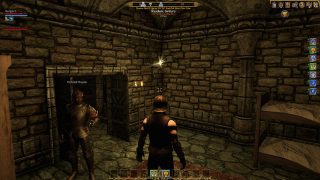 And this pretty much lays out the real problem of Shroud of the Avatar: the game is just not finished. There is no other way to describe it.
And this pretty much lays out the real problem of Shroud of the Avatar: the game is just not finished. There is no other way to describe it.
While it starts out pretty well in term of content (despite some obvious polishing issues) with well developed starter area (which are also different based on the path chosen) with a good number of quests, the more you further into the game, the less things to do there are!
Despite their excellent world design, many of the SCENES are sorely lacking in term of interesting content basically offering little more than hack’n slash exploration zones to fight monsters, with no quests, or NPCs. If it can be fun for a while because it is generally pleasant to explore these areas… it does get repetitive after a while and slowly removes any point of going there, especially as the loot and rewards are completely unbalanced, rarely offering anything worthwhile with crafting being the only real way to have some high quality gear. Besides, the contrast with the earlier SCENES of the game is staggering. SCENES surrounding the starter cities at the beginning of the quest tend to offer quests for many of them (that can be tied to specific events in a city, or a NPC you’ll meet in that specific SCENE) and even trying at times to offer slightly more original content with puzzles of varying complexity and even have quests that you solve by a philosophical choice between two Virtues. But the more you go into the game and story and the less you’ll find that sort of SCENES making exploration basically pointless and you sometimes get unto particularly obtuse design choice. For instance a specific puzzle late in the main plot has a solution that has to be guessed by looking at the size and positions of candles in another place, without the game really giving a hint as to how to understand it! It’s commendable to want to offer puzzles more complex than was most other RPGs have to offer, but when you end up with quests that appear impossible to solve without a walkthrough, it feels like it really lacked some proper QA to try out it this worked really well.
And that’s not even mentioning the number of SCENES that are still not complete or remain “clones” of other areas. While their quantity remains negligible compared to the number of complete scenes in term of world design (and really their number are dwindling), this is not really the case in term of the number of SCENES whose world design is finished but still feels to be sorely lacking in content.
But the most frustrating thing really comes from the cities and villages which basically represent both the best and worst that the game has to offer.
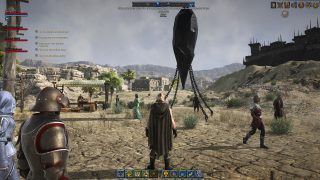 On one side you can find cities like Aerie, inhabited by dozens of unique NPCs, right up to the most simple guards or merchants. Pretty much every character you’ll meet there will have its own unique dialogue and personality, each with their own life and their own stories, and most will also have character schedules during the day. You won’t find places crowded with people in the middle of the night, indeed! And to put the icing on the cake, you’ll find multiple quests throughout the city as well. It’s one of these moments where the game showcases all of its potential as an Ultima game and can just captivate simply by spending hours just exploring a city and talking to its people, discovering them and the world… And if every towns and villages in Shroud of the Avatar followed suit, one would easily see his heart conquered by the game and happily claim “Ultima is back for good!”.
On one side you can find cities like Aerie, inhabited by dozens of unique NPCs, right up to the most simple guards or merchants. Pretty much every character you’ll meet there will have its own unique dialogue and personality, each with their own life and their own stories, and most will also have character schedules during the day. You won’t find places crowded with people in the middle of the night, indeed! And to put the icing on the cake, you’ll find multiple quests throughout the city as well. It’s one of these moments where the game showcases all of its potential as an Ultima game and can just captivate simply by spending hours just exploring a city and talking to its people, discovering them and the world… And if every towns and villages in Shroud of the Avatar followed suit, one would easily see his heart conquered by the game and happily claim “Ultima is back for good!”.
But… way too often, you stumble upon cities that are literally devoid of any life, sometime accompanied by a “Work in Progress” message, or worse cities with plenty of NPCs around… but whose dialogues consist of “I don’t a name yet !”. Hardly a good way to keep the player immerged in a fantasy world don’t you think? Now we could be forgiving if that only concerned small villages or really secondary cities… but it feels way more problematic when that also describes for instance Brittany, Lord British’s capital, or some of the cities visited during the main story! And the paradox here is that you can also find regions like the “Hidden Vale” that are very much finished in term of content… while they have no relevance to the plot. Which really makes you wonder how the studio handled their priorities…
As a result, exploring the overland despite its near total freedom, feels like more like a random game of chance where you never know if you’ll stumble upon something interesting… or something completely frustrating because of how empty or incomplete it is. On one hand you can stumble on a city filed with unique PNJs, some quest or a little dungeon area… or a small village with its own small sub-plot. One the other hand…? You can just as well stumble upon a major city with nothing to do except seeing non-NPCs with often no logical in term of what was completed or not. For instance you can get into that nice populated coastal cities where the mention that big city on that isle on the lake and how they like their simpler life here… but that lake city ? It’s empty! Even more crazily is that you have all those city like Yew again filled with non-NPCs… except you’ll have a couple of true NPCs somewhere in there to give an important quest. An issue which also happens during the main plotline. Frustrating and annoying as you get this feeling of moving from a true Ultima game to infuriating ghost towns.
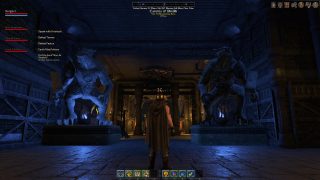 And I mentioned the issues of the interface earlier, but here as well it manages to really cheapens the dialogue due to how problematic it is : it’s hard to feel fully immersed in a well written dialogue when the way it is presented feels so off-putting. The possibility to both click or type keyword also give the sense of a dialogue system that couldn’t decide what it wanted to be. So you really have to learn to force yourself to forget the whole UI in order to plunge yourself into the dialogues, while really it wouldn’t have been that hard to create a simple dialogue interface separate from the rest of the game.
And I mentioned the issues of the interface earlier, but here as well it manages to really cheapens the dialogue due to how problematic it is : it’s hard to feel fully immersed in a well written dialogue when the way it is presented feels so off-putting. The possibility to both click or type keyword also give the sense of a dialogue system that couldn’t decide what it wanted to be. So you really have to learn to force yourself to forget the whole UI in order to plunge yourself into the dialogues, while really it wouldn’t have been that hard to create a simple dialogue interface separate from the rest of the game.
And how can I not mention companions? In Ultima tradition, Shroud of the Avatar offers three companions (that will only joins you if you play offline though), each being tied to a separate principle and representing a different “class”. They can make some comment during the adventure at specific places or events, sometimes (but rarely) intervene in dialogues and each offers their own quest. It’s pretty decent picture on the whole (though with still a lot of room for improvement) except it’s actually something that was added recently to the game: at launch two of the three companions only had for dialogue “This NPC is still in active development”. Which really feels like a bad joke. And considering the game isn’t really balanced for adventuring the world solo, depriving oneself of the companions isn’t a solution as they are pretty much required if you want to complete the game offline, while it’ll be recommended to team up with other players when playing online.
So sure, companions were improved since launch, but this really showcases the core issue of the game’s development.
Finally, we can’t mention the game’s issues without mentioning the “save” system, and yes it deserves these quotation marks. As you’d expect you can save anywhere and “Continue” the game where you left off… except the game basically doesn’t save ANYTHING about the state of the SCENE you are in! So if for example you save in the middle of a SCENE that you have pretty much emptied of monsters, explored and looted all its chest after you have opened two of three of the locks on the secret door leading to the biggest treasure… and you quit the game and come back… the SCENE will have been COMPLETELY reset! What about all the monsters you killed, the treasures you looted? They’re all back. And the locks? They’ll have been reset as well so you’ll have to find the keys again and start all over! It feels like an antiquated save system from an old console game: unbelievable! Same with the time of day which is based on real world time, so if you save at day… you can reappear at night. There is also no way to “pass time”, so good luck if you plan to use the Lunar Rifts to move around the world : you’ll have to wait till the cycle reach the place you want to go, which sometime amount to doing nothing for half an hour! Oh and it’s the same if you quit a SCENE and come back to it: it’ll have been reset! So we can only give advice not to quit or save the game until you have completed a SCENE at the risk of having to redo everything. And if you save and “load” a game instead of just using “Continue”? You’ll restart at the beginning of the scene, which might force you to have to redo a whole dungeon for example, even in the main plot!
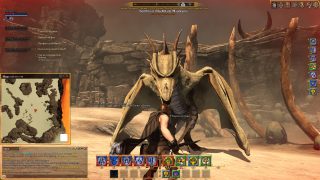 Basically this feels like an online system where someone quickly jerry-rigged a save system without really taking time to put a proper save system as you’d expect in any single player offline game. That’s not exactly painting a good picture of the development, and it’s also not consistent with what had been announced as we’d been promised that the offline version of the game would have SCENES not resetting and a limited respawn. Another aspect obviously not complete.
Basically this feels like an online system where someone quickly jerry-rigged a save system without really taking time to put a proper save system as you’d expect in any single player offline game. That’s not exactly painting a good picture of the development, and it’s also not consistent with what had been announced as we’d been promised that the offline version of the game would have SCENES not resetting and a limited respawn. Another aspect obviously not complete.
Of course paying online remains a viable solution since the entire story is available as well, but it’s far from being perfect as well. For instance the entire economy is player-based, making any other source of gear basically moot and the balancing is so focused on multiplayer than completing the story alone can be very complicated… whereas having companions offline changes the deal. One must also mention the ludicrous amounts of player towns that clutters the countryside and pretty much kill any hope of immersion (there were thankfully removed offline, but one feel that a toggle to hide them online wouldn’t be a bad idea) and who basically are of no interest if you don’t plan to dabble in the player community aspect of the game. It should also be noted that playing online suffers from much longer load times and a much uneven framerate because of how many player made content has to be loaded everywhere…
So there aren’t really any perfect solutions to have the best experience as both online and offline have their share of issues.
A interest… that’s become « legend » ?
And yet, despite all that, despite all these obvious flows and issues… it’s hard for an Ultima fan not be slowly captivated by the plot and the core design of the game which reminds us of many old-school games: the freedom is almost total with often this feeling of just being dropped in the world and having to fend for yourself, and the atmosphere manage to recreate some of the best moments of Ultima.
The story much like the world is rather interesting and you take pleasure at slowly discovering this New Britannia and its lore. There are still some obvious holes (Who the eck are this Ebon Cult and these Cabalist besieging the cities of Virtues?) but still the plot manage to remain interesting all the way through and all the aspects reminding one of Ultima are very pleasing, with references that can be more of less direct but that for the most part hit straight at home in term of creating a great nostalgic feeling, right up till the very final act of Forsaken Virtue than can only captivate the heart of any true Ultima fan…
It’s also rather enjoyable the game doesn’t just consist of mimicking Ultima and its old Britannia and one of the most surprising and interesting aspect is actually the addition of non human races to the world. While this choice could leave one a skeptic at first (did Ultima really needed elves?), it actually ends up being one of the most interesting aspect of the game both by their culture and their story. We can’t fully praise the result, because as with everything else… you can feel the incompleteness creeping in: as fascinating as the Kobolds of the Fauns are… it’s hard to feel as strongly involved as with the Gargoyles of Ultima VI when most of their denizens are basically copies of a same NPC. And yet… there aren’t many game who managed to make me feel bad for killing my opponents…
Still the three core storyline manage to remain interesting despite being mostly linear, and also succeed at not repeating themselves whether by their content or their ultimate goals. I really need to mention the pretty formidable ending to the Path of Truth, and the rather smart choice to have the Path of Love associate us to a companion for most of the adventure. So in term of narrative, Shroud of the Avatar is has its up and downs with its incompleteness preventing it to reach its full potential… but we can at least consider that as far as the main storyline goes, the positive wins out on the negative by a large margin despite an ending that isn’t really one with story arcs left wide open for Episode 2…
A dodgy legend
Frustrating, irritating, unfuriating… but also intriguing, captivating and deeply enjoyable: this is very much the paradox that is Shroud of the Avatar which manage to offer an experience and an atmosphere as we hadn’t seen in a long time… but at the same time build up frustration and feels like a slap in the face for a game that is available for sale while it would barely deserves to be called a beta.
How to recommend it as it is? Honestly: I can’t. I’ve mentioned and reviewed multiple rushed games at release over the years, but this goes much farther: we’re not talking of bugs or instabilities (to Portalarium’s credit, this is no Ultima IX or Gothic 3) but about parts of the game that are literally missing or not done, with parts of the plot basically missing and remaining unexplained.
Now we can appreciate Portlarium’s dedication in term of adding content and fixes every month since release: we’ve seen some cities get their NPCs, new quests appear, companions becoming proper NPCs or some very notable graphical enhancements… but how can we praise a developer for doing now what should have ALREADY been done BEFORE release ? And looking at the latest development with layoffs and apparent financial troubles they seem to be facing as they seem to want to focus already on the second episode… one would hard pressed to figure out how things will evolve in the future and whether this first episode will already be completed.
Shroud of the Avatar isn’t a bad game; there are too many good things there to just dump the game into the long list of crappy games we get each year. But it’s not a good game either, barely a mediocre one with good things popping out. The most frustrating thing is this feeling that this could truly have been an excellent game (and perhaps with time it could still be), and you can really feel it at these times where everything that made Ultima so special come to the forefront.
But the gist of it really is that by wanting to do a game that was basically both Ultima X and Ultima Online 2, Richard Garriott and his team tried to bite more than they could chew with a very ambitious project that they obviously didn’t have the resources or the manpower to pull off. As a result, we have a game that won’t fully satisfy fans of either genre as the issues are numerous both offline and online. We know that Richard Garriott has been passionate by online games ever since the success of Ultima Online twenty years ago, but it’s become increasingly apparent that his strengths and talents shine the most in everything that is not “online” seeing as how all the best aspect of the Shroud of the Avatar are precisely all that reminds us directly of the old single player Ultima games. So it’s hard not to feel that it would have been better for Lord British to come back with a good old focused single player game, and then perhaps make an online version of it afterward…
Because in the end all that his latest endeavors risks of being remembered for is for its wasted potential and basically being a letdown… And both Lord British and Ultima deserves better than that.

